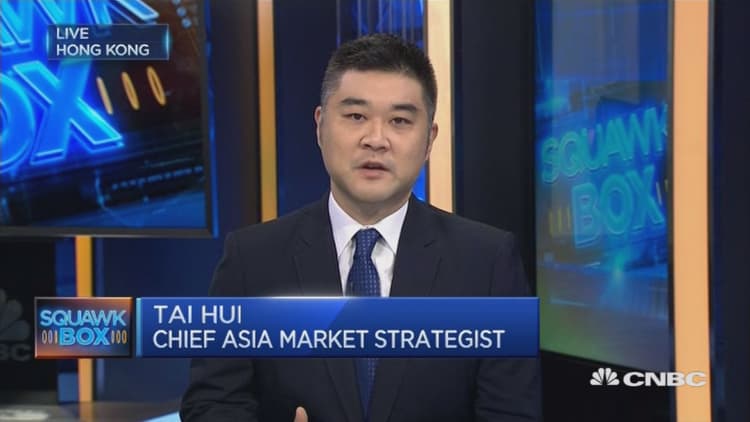With rising U.S. interest rates threatening overall bond returns, savvy investors are looking abroad to keep savers in the game.
It's an odd twist, since higher yields, as such, are good for investors who want income. But because a bond's principal value falls as rates rise, a raft of bond funds — both active and passive — are turning to bonds from emerging markets, where rates are still being held at low levels to sustain the total returns investors want.
The Bloomberg Barclays index tracking emerging market bonds is up 4.3 percent this year, unhedged for currency, and a total of 28 percent for the last five years, more than double the gains for the Bloomberg Barclays U.S. Bond Aggregate Index.
Exchange-traded funds have embraced the trend with gusto. ETF Database tracks 19 emerging market bond funds, all of which have positive returns for the year. The average emerging market ETF is up about 5 percent so far this year, with returns of more than 7 percent for a handful of emerging market bond ETFs, including the SPDR Barclays Capital Emerging Markets Local Bond ETF (EBND), WisdomTree Emerging Markets Local Debt Fund (ELD), iShares Emerging Markets Local Currency Bond ETF (LEMB), VanEck Vectors Emerging Markets Aggregate Bond ETF (EMAG) and $3.4 billion VanEck Vectors J.P. Morgan EM Local Currency Bond ETF (EMLC).
"We have a huge valuation difference between emerging markets and the U.S. right now, and that's why we see so many asset managers moving money toward emerging markets," said ETF.com chief executive Dave Nadig, who has been chronicling a rush of institutional assets into emerging market debt funds. "It's an ebb and flow."
For investors who actively follow the markets, this is a narrative that has received a lot of focus — but mostly when it comes to stocks. Big-name market gurus, such as index pioneer Rob Arnott of Research Affiliates, are advising investors to overweight international and emerging market stocks because they offer much better value than U.S. stocks. Bond investors should also be taking a look at emerging markets exposure.
More from Trading the World:
An investing approach Bogle and Buffett may be wrong about
The links between national happiness and investing success
The big buyback boom — beyond the US
The trend is pronounced in actively traded bond funds, many of which are also looking to emerging markets to replace paper from out-of-favor categories ranging from bonds of retailers to long-dated U.S. Treasuries, which are up 1.4 percent this year measured by total return.
"The only place active has had any legs in ETFs is in bonds," Nadig said.
Year-to-date, though, the big emerging markets play made by investors is into emerging markets stock funds. Only iShares JPMorgan USD Emerging Markets Bond ETF (EMB) has amassed billions in new flows from investors, $2.7 billion through May 11, according to XTF.com. Only three other emerging market bond ETFs have taken in more than $100 million: EMLC ($868 million), PowerShares Emerging Markets Sovereign Debt ($423 million) and the iShares Emerging Markets High Yield Bond ETF ($159 million).
The top five emerging markets equity ETFs, by flows, have taken in roughly $15 billion from investors in 2017. Meanwhile, flows to U.S. fixed income ETFs remained positive last week, and for the year, the top five U.S. bond ETFs have taken in $15 billion from investors.

For average investors, funds are essential because the bond market is a thicket, with literally millions of securities, in contrast to about 100,000 common stocks traded on global markets, according to Morningstar research manager Maciej Kowara.
The same variety in available bonds that confuses mom-and-pop investors helps active managers beat exchange-traded funds tracking benchmarks, like the Bloomberg Barclays U.S. Aggregate Bond Index about 65 percent of the time, according to Morningstar.
"It is much harder [for a small investor] to be successful in replicating active funds in the fixed-income space than in equities," Kowara said. "That is because of the sheer size and complexity of fixed-income markets and liquidity. Active managers may have the luxury of earning a liquidity premium by holding less-liquid bonds, since most bonds trade little or not at all."
Certainly, bonds collectively don't often beat stocks, especially when equities are doing at all well. The Bloomberg Barclays U.S. Aggregate index's total return has been a compound average of 4.1 percent the last five years, trailing the 18 percent of the Standard & Poor's 500-stock index, notes CFRA Research investment strategist Sam Stovall.
Vanguard founder and index guru Jack Bogle recently said stocks are a better deal than bonds, but he was talking in a U.S.-centric context.
Bonds' big issue has been that hard economic data this year has been weaker than sentiment indicators, whose post-election surge convinced markets that faster growth was near at hand.
Sentiment predicting a pickup in U.S. growth began to push rates higher, but the yield on the 10-year bond fell to an April low of 2.17 percent from about 2.6 percent in March. It has rebounded to around 2.4 percent, helped by the quarter-point rate increase the Fed pushed through this spring and comments by Fed governors hinting at more hikes to come this year.
The largest emerging-markets ETF is the iShares J.P. Morgan USD Emerging Markets Bond ETF EMB, sponsored by industry giant BlackRock. With $10 billion under management, it has risen 5.4 percent this year, placing it eighth among the 19 passive funds in the segment, according to ETF Database. Its top 10 holdings are split between government bonds from Eastern European nations, like Russia and Hungary, and South American sovereign issuers such as Uruguay and Peru.
The best performers have returned about 7 percent so far in 2017, highlighted by VanEck Vectors J.P. Morgan EM Local Currency Bond ETF, according to ETF Database. Its $3.3 billion in holdings are led by plays on Mexico, Brazil and Asian nations, such as Indonesia, Thailand and the Philippines, some of which have lower bond ratings.
— By Tim Mullaney, special to CNBC.com




